Ahlian Jian Insights
Exploring the latest trends and news in various fields.
Keyboard Clicks and Clacks: The Symphony of Mechanical Bliss
Discover the mesmerizing world of mechanical keyboards! Join us as we explore the symphony of clicks and clacks that brings joy to typists everywhere.
The Evolution of Mechanical Keyboards: A Journey Through Time
The journey of mechanical keyboards began in the early 1980s, revolutionizing how we interact with computers. Initially designed for early computing systems, these keyboards utilized individual mechanical switches beneath each key, providing tactile feedback and durability that surpassed their rubber dome counterparts. Over the decades, as technology advanced, the popularity of mechanical keyboards surged among gamers and typists alike, leading to the development of various switch types such as Cherry MX, Razer, and Logitech, each offering unique feel and performance attributes. This evolution not only improved typing speed but also transformed the user experience, solidifying the place of mechanical keyboards in both gaming and professional environments.
As we moved into the 21st century, mechanical keyboards underwent significant changes in design and functionality. The introduction of customizable RGB lighting, programmable keys, and compact layouts catered to a diverse audience seeking both aesthetics and efficiency. Furthermore, the rise of enthusiasts and hobbyists led to a thriving community dedicated to building and customizing their unique keyboard setups. Today, mechanical keyboards are more than just typing tools; they are considered an extension of personal expression and productivity, symbolizing a fusion of technology and art that continues to evolve with each passing year.

How to Choose the Perfect Mechanical Keyboard Switch for Your Typing Style
Choosing the perfect mechanical keyboard switch for your typing style can greatly enhance your overall typing experience. With a variety of switches available, including linear, tactile, and clicky, understanding their differences is crucial. Linear switches, like the Cherry MX Red, offer a smooth keystroke without tactile feedback, making them ideal for fast typists. Tactile switches, such as the Cherry MX Brown, provide a noticeable bump when the key is actuated, helping typists to know when their input has registered. Meanwhile, clicky switches, like the Cherry MX Blue, not only give tactile feedback but also produce an audible click, which some typists find satisfying.
To find the right switch, first assess your typing style and preferences. If you primarily type and appreciate a quieter experience, linear switches may be your best bet. However, if you enjoy tactile feedback that can improve your typing accuracy, consider tactile switches. For those who love the sound of typing and don’t mind some noise, clicky switches could be the perfect fit. Additionally, it may be helpful to test different switches at a local store or through a switch tester before committing to your choice. Remember, the right switch can significantly boost your productivity and comfort while typing!
What Makes Mechanical Keyboards So Satisfying? Exploring the Sounds and Feel
Mechanical keyboards have gained immense popularity among both casual users and serious gamers, primarily due to their satisfying tactile feedback and auditory experience. Unlike traditional membrane keyboards, mechanical keyboards use individual mechanical switches for each key, which provide a distinct feeling with every keystroke. This responsiveness allows for a more immersive typing experience, making each keystroke feel deliberate and impactful. Users often report that the sound and feel of mechanical switches can enhance their focus and productivity, allowing them to fully engage with their tasks.
One of the key aspects that makes mechanical keyboards so satisfying is the variety of switch types available, each offering different sounds and tactile sensations. For instance, clicky switches produce a crisp sound with a tactile bump, while linear switches offer a smoother, quieter experience. Many enthusiasts enjoy experimenting with these different switches to find the perfect combination of sound and feel that suits their personal taste. As a result, mechanical keyboards not only cater to functional needs but also provide a unique sensory experience that can make the act of typing feel enjoyable and rewarding.